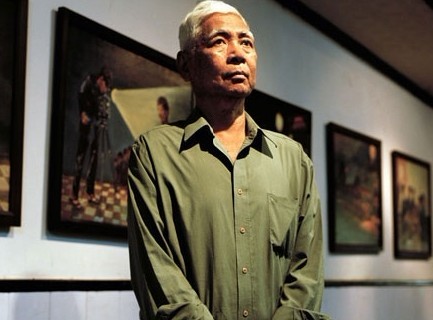Obituary;Vann Nath
When he was 52, with a hand that still trembled, Vann Nath produced a painting of a young man lying under a blossoming tree. He was playing a pipe while, in the background, cattle grazed by green palms in some bucolic corner of Cambodia. It was meant to be a self-portrait, he said, a beautiful memory from his childhood. He wanted only to paint idyllic landscapes now, in the style of temple murals or the French Impressionists who had first inspired him to take up art.

52岁的时候,用还在颤抖的手,凡纳(Vann Nath)画了一幅画:一位少年躺在开满花的树下吹着牧笛,牛儿在吃草,背后是柬埔寨某些村落里可见的绿棕榈。他说这原本是幅自画像,是童年的美好回忆。现在的他只想画田园风光,像寺院壁画或法国印象派那样,是他们把自己领上了艺术之路。
That was because, in 1978-79, he had been made to paint quite different pictures. In those months he was interned in S-21 prison, a former French lycée in Phnom Penh which had been converted into a torture-compound for alleged enemies of the Khmer Rouge regime. Perhaps 14,000 people were sent to S-21 for a daily routine of electrocution, water-boarding and flagellation before being carted off for execution—a shovel or spade to the head—at the nearby “killing fields”. Mr Vann Nath was one of only six or seven prisoners to make it out alive.
He never expected to. Like almost all the others, he had no idea why he had been sent there. He was not an intellectual; his family was poor and provincial, and he just a painter in a small business making signs and billboards. In 1975, obedient to the Khmers Rouges, he had joined a peasant commune and worked hard there. When he first saw the wasted prisoners in S-21, he thought it was all over for him. But after withering away for a month, fed so sparely on rice gruel that he felt an urge to consume the flesh of the dead, he was asked to paint portraits of the regime’s leader, Pol Pot.
At first he thought he could not do it. The shocks and beatings meant that he could barely stand. Besides, he had no idea what Pol Pot looked like, and only a black-and-white photograph to copy. All the time he painted, day and night, the screams of the tortured echoed from other rooms. He hoped, with every brush-stroke, that his jailers would like his work and let him live. He focused by thinking how much he would like to kill the man he drew.
Nonetheless, he carried out the task to the satisfaction of Duch, the prison commandant, the one—and still only—former cadre now being held to account for his role in the revolution. For his flattering portraits, giving Pol Pot a fresh-faced girl’s rosy cheeks, Mr Vann Nath’s name in the prison ledger was tagged “Keep for use”. But for that “keeping”, he often said, he would be dead.
When a Vietnamese invasion swept the Khmers Rouges from power, in January 1979, his portrait-painting ended. But in 1980-81 an even more harrowing spell of art began. The fleeing warders of S-21 left behind troves of documents outlining the prison’s work, but it was Mr Vann Nath, painting his memories in sombre oils, who showed most vividly what had happened there. Blindfolded men, women and children trucked into the compound in the middle of the night. Men carried, trussed like pigs, on bamboo poles. Babies torn from their mothers’ arms—to be smashed against walls, he learned later. Prisoners prodded, whipped and steered by stone-faced cadres into holding cells to be crammed side by side, like decaying logs. For many years after the Khmers Rouges fell from power, the upper echelons of the regime denied S-21’s existence. Mr Vann Nath caught its reality in furtive glances, as he moved from cell to workshop.
He painted by stilling his mind, in a process both painful and therapeutic. But painting still made no sense of what he had seen. It seemed to him that Cambodia could not cleanse itself of such an evil, and that his works were not good enough to do such horror justice. He only hoped the souls of those who had died would get some ease from them.
When S-21 was turned into a museum of the national self-genocide he had witnessed, some of his pictures hung on the walls. One day, for the first time since 1979, he saw one of his former jailers there, a “tiger” he had dreaded. Having puffed a few cigarettes to steel himself—for he was always a man of poise, despite his tormented past—he approached him affably and guided him by the shoulder to his paintings hanging there. “Is this accurate?” he asked. It was, the jailer conceded.
The international media, whose questions about S-21 he patiently answered time after time, called him Cambodia’s Goya. He brushed it off. His principal fear was that young Cambodians would not learn about—or, worse still, would not believe—what he had witnessed. He painted, he said, so that Cambodia would never turn on itself so monstrously again.
Silent witness
Two years ago Mr Vann Nath took the stand as a witness against Duch, his former master, who is now appealing a 35-year jail sentence handed down by a UN-backed war-crimes court in Cambodia. A second trial, of four senior leaders of the regime, is not expected to start until next year. The defendants say they are too ill to stand trial. They are attended, however, by a world-class team of doctors; Mr Vann Nath, who suffered years of kidney disease, struggled to afford even basic care. His testimony will be missing from subsequent proceedings. His paintings, however, speak for him.











